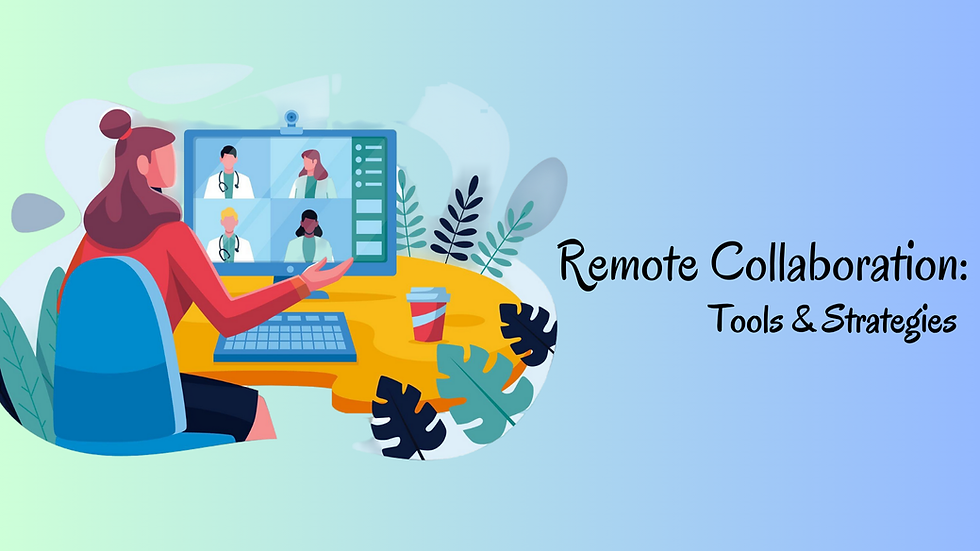Remote Collaboration: Tools & Strategies For Virtual Teams
- garyconnie72
- Jun 24, 2024
- 3 min read
It has become increasingly prevalent, driven by the rise of global teams and the need for flexibility in work arrangements. Effective remote-collaboration bridges the gap between team members who may be scattered across different time zones, cultures, and work environments.
Central to remote collaboration are digital tools that facilitate communication, project management, and document sharing. Platforms like Slack, Microsoft Teams, and Zoom have revolutionized how teams interact, enabling real-time messaging, video conferencing, and collaborative document editing. These tools not only enhance communication but also ensure that team members can work together seamlessly, regardless of their physical location.
Key to successful remote-collaboration is the establishment of clear communication protocols and expectations. This includes defining which tools to use for different types of communication—instant messaging for quick questions, email for formal communications, and video calls for meetings. Additionally, fostering a culture of transparency and inclusivity is crucial, ensuring that all team members feel connected and engaged, despite the physical distance.
Remote Team Collaboration
Remote team collaboration involves using digital tools and strategies to facilitate effective teamwork among members who are geographically dispersed. It has become a crucial aspect of modern work environments, driven by the increase in remote work arrangements and global teams. Here’s an overview of key components and best practices for successful remote-collaboration:
Communication Tools: Platforms like Slack, Microsoft Teams, and Zoom enable real-time communication through instant messaging, video conferencing, and calls. These tools are essential for maintaining regular contact, hosting virtual meetings, and ensuring that team members can quickly address issues and share updates.
Project Management Software: Tools such as Trello, Asana, and ClickUp help teams organize tasks, set deadlines, and track progress. These platforms often include features for assigning tasks, setting priorities, and visualizing workflows, which help keep everyone on the same page.
Collaborative Document Editing: Google Workspace and Microsoft 365 provide cloud-based solutions that allow multiple users to work on the same documents simultaneously. This is crucial for creating and editing shared files, ensuring that all team members have access to the latest versions.
Collaboration Tools For Remote Teams
Collaboration tools have become indispensable for remote teams. These tools foster communication, enhance productivity, and ensure seamless project management, despite the physical distances separating team members.
Among the most popular are communication platforms like Slack and Microsoft Teams, which offer instant messaging, video conferencing, and integration with other software, allowing for real-time discussions and quick decision-making for work from home people. Video conferencing tools such as Zoom and Google Meet have revolutionized virtual meetings, making face-to-face interaction possible, which is crucial for maintaining team morale and clarity.
Project management tools like Trello, Asana, and Monday.com help teams organize tasks, set deadlines, and track progress through visual boards and timelines, ensuring everyone is on the same page. For document collaboration, Google Workspace and Microsoft Office 365 provide cloud-based solutions where multiple users can work on documents simultaneously, leaving comments and edits in real-time.
Is Employee Monitoring Software Worth It?

The worth of employee monitoring software largely depends on the specific needs and goals of a business. Here are some key considerations:
Pros
Productivity Tracking: Employee monitoring software can help track productivity by providing data on how employees spend their time. This can identify inefficiencies and help optimize workflows. Tracking employees can also be considered a Productivity Hack.
Accountability: It ensures employees are accountable for their work, which can be particularly important in remote work settings where direct supervision is challenging.
Security: Monitoring software can protect sensitive information by detecting unauthorized access and preventing data breaches.
Time Management: It can track time spent on various tasks, helping managers allocate resources more effectively and employees manage their own time better.
Cons
Privacy Concerns: Monitoring can lead to privacy issues and create a sense of distrust among employees. It's crucial to implement it transparently and ethically.
Morale And Trust: Over-monitoring can negatively impact employee morale and trust. Employees may feel micromanaged and stressed, which can reduce overall job satisfaction and productivity.
Cost: Implementing and maintaining monitoring software can be costly, and businesses need to weigh this against the potential benefits.
Legal Implications: There are legal considerations and regulations regarding employee monitoring that vary by region. Companies must ensure compliance to avoid legal issues.
Conclusion
In conclusion, remote collaboration are essential in today's increasingly digital and globalized work environment. They bridge the gap created by physical distances, enabling seamless communication, efficient project management, and collaborative work on documents and code.
Tools like Slack, Zoom, Trello, and Google Workspace ensure that remote teams can stay connected, organized, and productive. By fostering a culture of transparency, accountability, and continuous communication, these tools not only enhance productivity but also support team morale and cohesion. As remote work continues to grow, the importance and utility of these collaboration tools will only increase, making them indispensable for the future of work.
